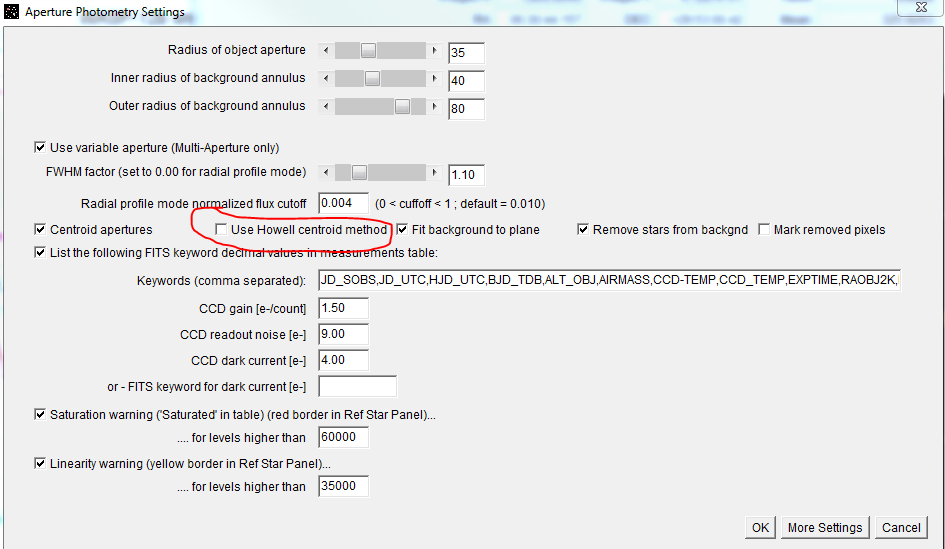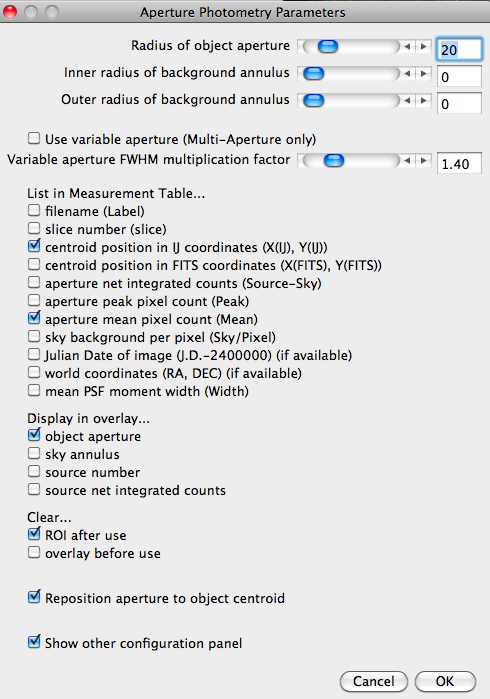Accuracy of Centroid Measurement
Accuracy of Centroid Measurement
|
I am involved in a double/binary star measuring project using 'lucky imaging' stacked jpeg images. I have been using Astroimage J (AIJ) to find the centroids of the two stars. I then use simple Pythagorean geometry to find the separation and position angle of the stars. The scientific accuracy of my work depends a great deal on these centroid calculations.
The centroids given for a typical star by AIJ are given to six decimal places (!) of a single pixel. How many of these digits are scientifically significant? (The pixels on my camera are 4.2 microns square so the sixth decimal place puts us into the realm of the larger organic molecules in size which is a bit much I think you will agree...) TPerhaps more troubling is that there is always some variation of these values. Because of this variation I take 5 centroids and then find the mean of the values. Here is a typical set of (x-values only) centroids for a star. y-values vary in a similar fashion. 250.373143 250.371879 250.363256 250.375980 250.365331 I am using an aperture wide enough to include all the pixels involved in the star image. I only use stellar images which are not saturated so all pixel values are below 255. How, exactly, are the centroids calculated? Why is there variation at all if there are no saturated pixels in the star image? Should be a fairly simple algorithm - take the value and location of each pixel and.... Thanks you for the excellent software and for your time taken to answer the questions. Dave Cotterell, Blackwater Observatories, Toronto, ON |
Re: Accuracy of Centroid Measurement
|
Administrator
|
Hi Dave,
As far as the accuracy of the centroid measurement, I don't have much information to offer. I think it would depend on several factors, including star brightness and PSF shape (e.g. focused vs. defocused). Also, the measured centroid location depends somewhat on where the starting point is relative to the final determined centroid location. However, the "Howell" centroid option (see below) gives very repeatable results, no matter where the starting point is (within reason). Do you have the "Howell centroid method" enabled or disabled in aperture settings? AIJ currently reports all measurements using 6 decimal places, so there is no intended precision due to the number of reported decimal places. There are actually two different methods of centroiding in AIJ, which can be selected by clicking the "Change Aperture Settings" icon ( If you are able to characterize the precision, in one or both centroid modes, I would be interested to know about your findings, once they are public.  Karen |
Re: Accuracy of Centroid Measurement
|
Thanks for getting back to me so quickly, Ms. Collins (if I may be so bold...)
I am using a MacOS version of AIJ and, to the best of my knowledge it does not offer the Howell Centroid method.. I use very accurately focused images which appear quite round to slightly oval (depending on seeing and atmospheric dispersion) and have a distinct central brightening like a proper PSF should... I try very hard to avoid saturating any of the pixels by careful attention to exposure times and ISO settings. I'm working at 0.275 arc seconds per pixel plate scale..... When I press the Aperture settings I get this screen:  I have done some experimentation just now and, not to bore you with the details, it seems that as I increase the radius of the aperture beyond the radius of the star image, the range of 5 centroid values, in both x and y, seems to converge on a constant value. i.e making the aperture greatly larger than the star offers no accuracy improvement. In my experiment a star that was 20 pixels by 20 pixels (10x10 radii) gave centroids that ranged no more than 0.025pix once the aperture was increased beyond 10 pixels. At the plate scale I am working with this gives an error bar only 0.0069 arcseconds which is beyond fabulous!!! (It's actually waaaay down in the noise....) If my version of AIJ does not do 'Howell' centroids, can I assume that it is calculating the centroids by the "Center of Mass" method? This is interesting! Dave |
Re: Accuracy of Centroid Measurement
|
Administrator
|
Hi Dave,
You must be running an old version of AIJ. You can check by going to AIJ_Toolbar->Help->'About AstroImageJ...'. Older releases only offered the center of mass centroid method. You should update to the latest release, which is 2.1.5. If you don't see the Howell option after upgrading, please let me know. The upgrade is an easy. Follow these instructions. ------------------------------------------------ After installation of a full release of AIJ, be sure to use the AIJ update feature to update to the latest build. Follow these steps: 1) Start AIJ and go to the AIJ toolbar menu item: Help->Update AstroImageJ... 2) Select the latest version from the pull down menu 3) Click OK and 3 files will download and install 4) AIJ will then automatically close 5) When you start AIJ again, you will be running the new version The 'daily build' in the pull down menu is the latest beta version. If you are having a particular problem, or just want to help out with beta testing, download that version rather than the highest numbered version. When you are running a daily build version, the AIJ version number will begin with "db" to indicate that it is a daily build. Release notes are available by clicking the "Release Notes" button on the update panel. ------------------------------------------------- Karen |
«
Return to AstroImageJ
|
1 view|%1 views
| Free forum by Nabble | Edit this page |

